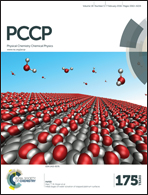Shrimp-shell derived carbon nanodots as carbon and nitrogen sources to fabricate three-dimensional N-doped porous carbon electrocatalysts for the oxygen reduction reaction†
Abstract
Development of cheap, abundant and metal-free N-doped carbon materials as high efficiency oxygen reduction electrocatalysts is crucial for their practical applications in future fuel cell devices. Here, three-dimensional (3D) N-doped porous carbon (NPC) materials have been successfully developed by a simple template-assisted (e.g., SiO2 spheres) high temperature pyrolysis approach using shrimp-shell derived N-doped carbon nanodots (N-CNs) as carbon and nitrogen sources obtained through a facile hydrothermal method. The shrimp-shell derived N-CNs with a product yield of ∼5% possess rich surface O- and N-containing functional groups and small nanodot sizes of 1.5–5.0 nm, which are mixed with surface acidification treated SiO2 spheres with an average diameter of ∼200 nm in aqueous solution to form a N-CNs@SiO2 composite subjected to a thermal evaporation treatment. The resultant N-CNs@SiO2 composite is further thermally treated in a N2 atmosphere at different pyrolysis temperatures, followed by acid etching, to obtain 3D N-doped porous carbon (NPC) materials. As electrocatalysts for oxygen reduction reaction (ORR) in alkaline media, the experimental results demonstrate that 3D NPC obtained at 800 °C (NPC-800) with a surface area of 360.2 m2 g−1 exhibits the best ORR catalytic activity with an onset potential of −0.06 V, a half wave potential of −0.21 V and a large limiting current density of 5.3 mA cm−2 (at −0.4 V, vs. Ag/AgCl) among all NPC materials investigated, comparable to that of the commercial Pt/C catalyst with an onset potential of −0.03 V, a half wave potential of −0.17 V and a limiting current density of 5.5 mA cm−2 at −0.4 V. Such a 3D porous carbon ORR electrocatalyst also displays superior durability and high methanol tolerance in alkaline media, apparently better than the commercial Pt/C catalyst. The findings of this work would be valuable for the development of low-cost and abundant N-doped carbon materials from biomass as high performance metal-free electrocatalysts.


 Please wait while we load your content...
Please wait while we load your content...